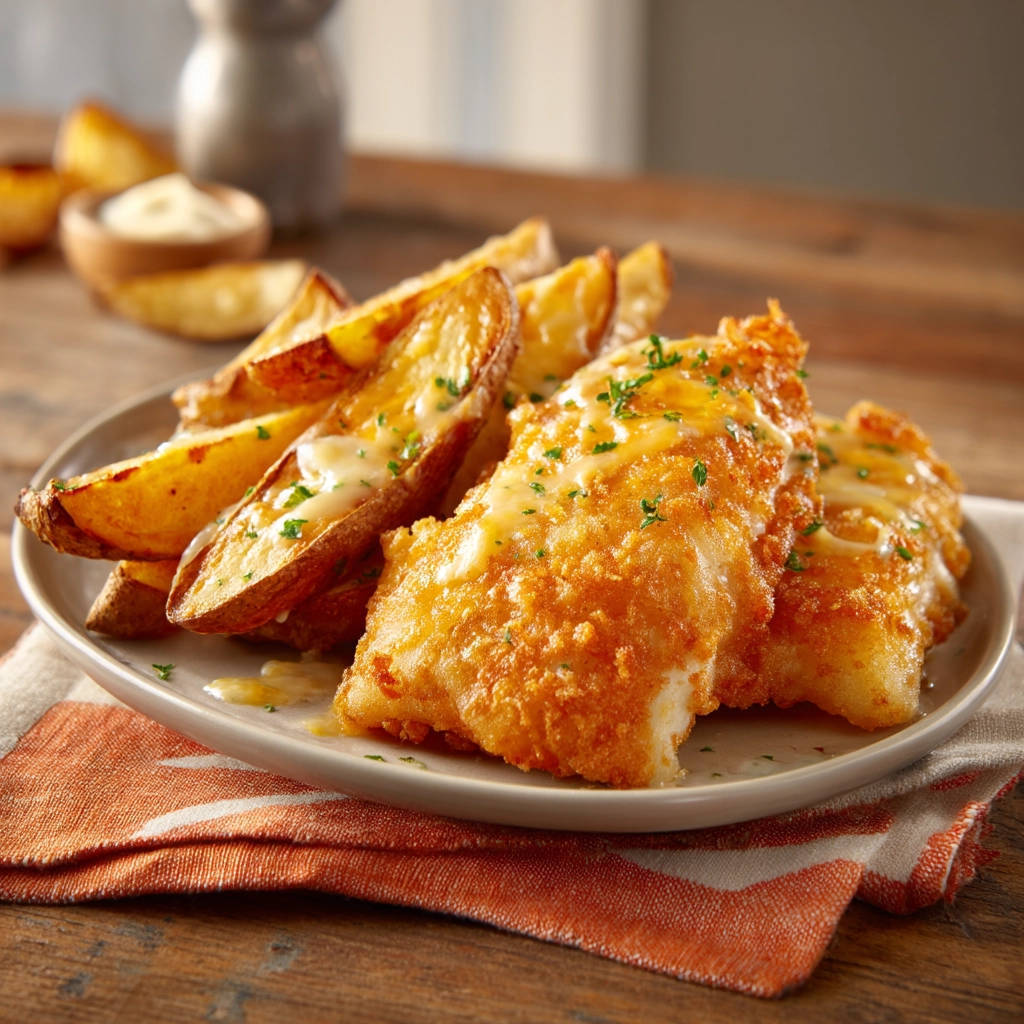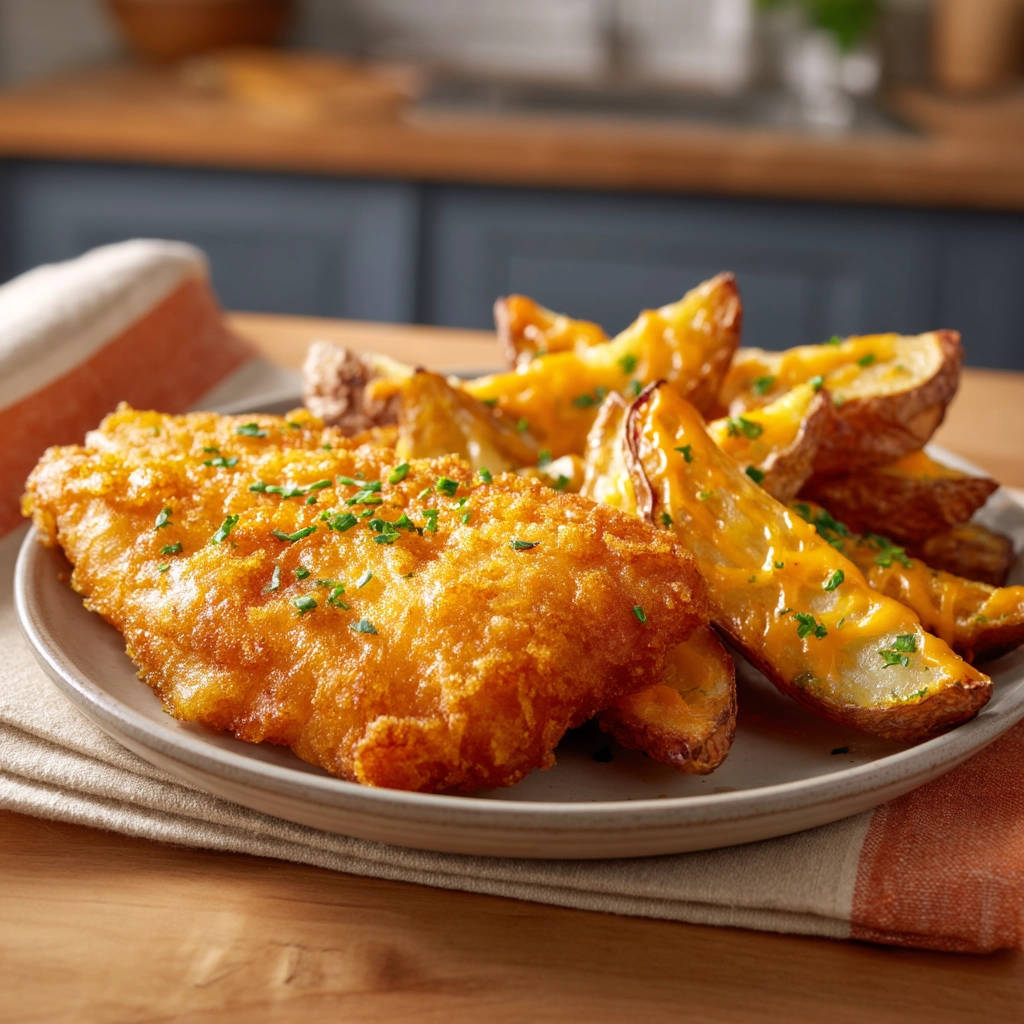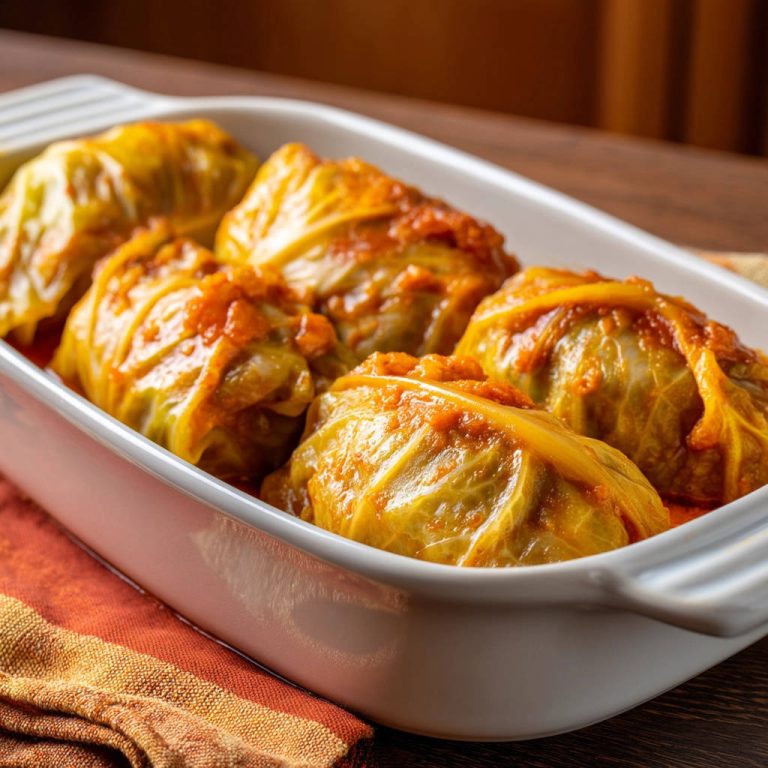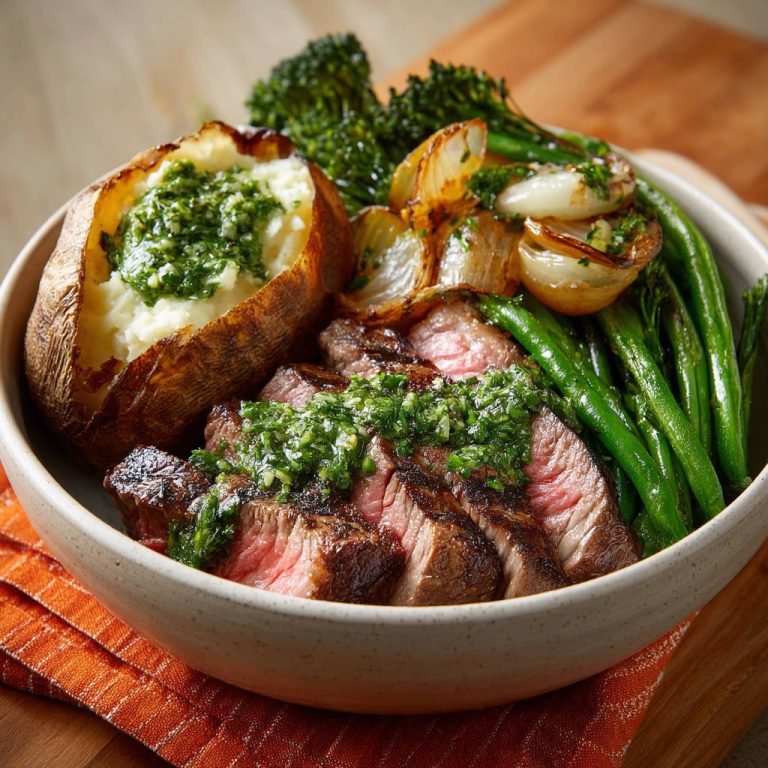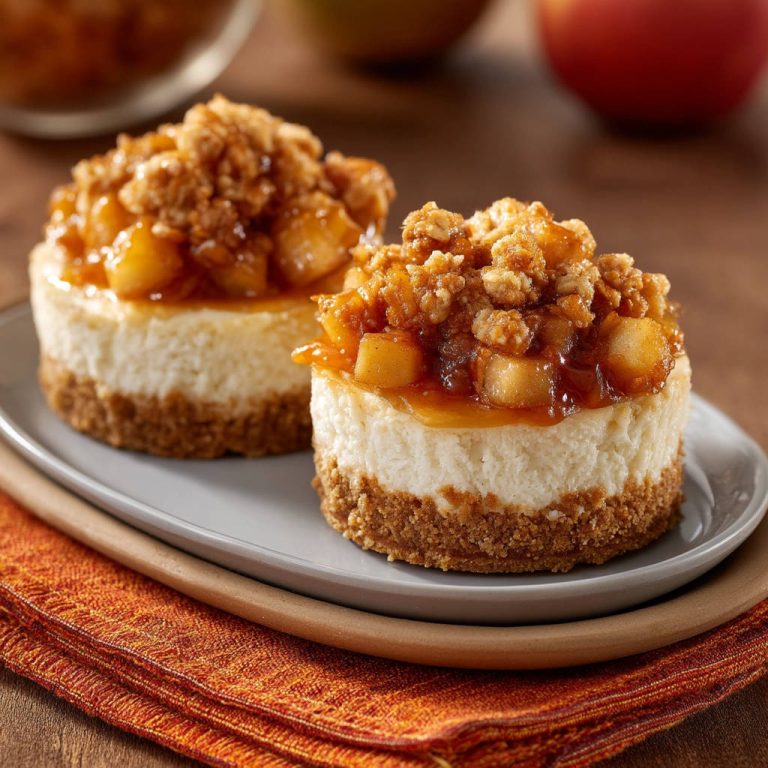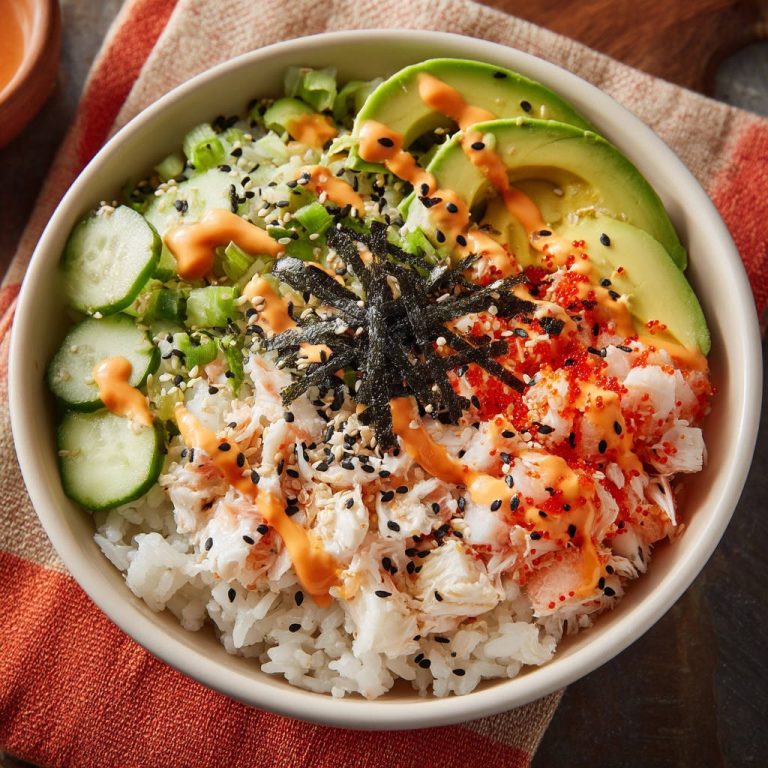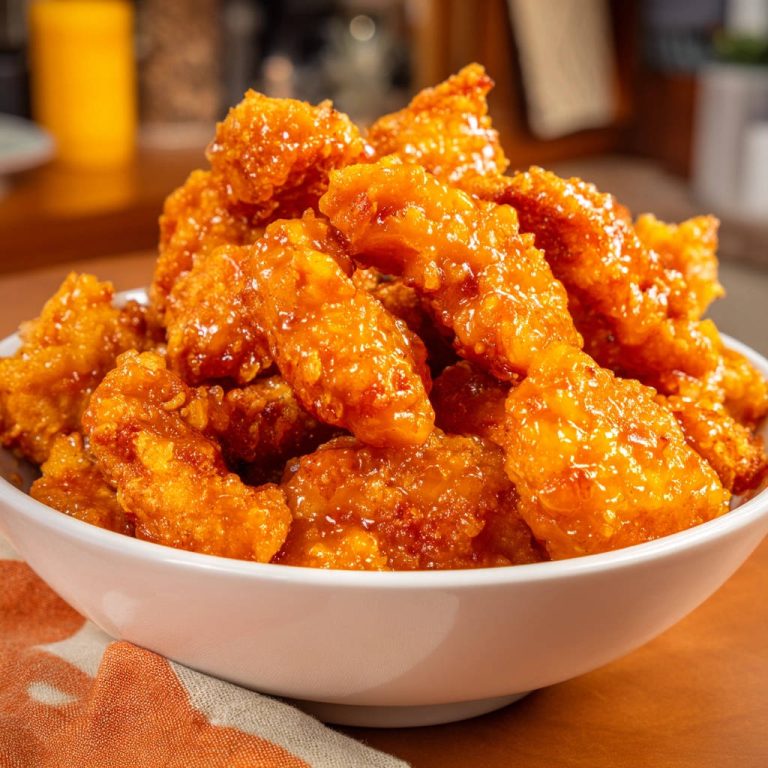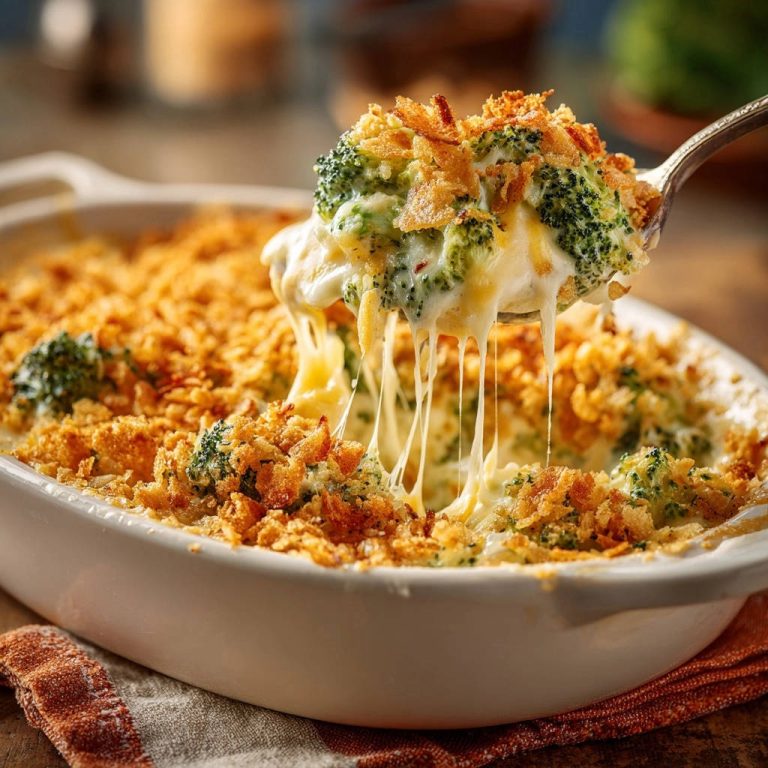There’s nothing quite as disappointing as putting in the effort to make fried fish at home, only to bite into a beautiful golden crust that’s sadly… soggy. We’ve all been there, right? For years, I struggled to replicate that incredibly crispy, light batter you get from a fantastic fish and chips shop.
But friends, I finally cracked the code! It involves a few simple techniques and one key ingredient that changed my fried fish game forever. Paired with fluffy, seasoned wedges drizzled with warm, creamy cheese sauce, this crispy fried fish with cheesy wedges recipe is pure comfort food heaven. Say goodbye to soggy disasters and hello to guaranteed golden, crunchy perfection!
Why You’ll Absolutely Love This Recipe
Beyond solving the dreaded soggy batter problem, this dish is a winner for so many reasons:
- Unbeatable Texture: The fish has a shatteringly crispy exterior with flaky, tender fish inside.
- Perfectly Matched Sides: The baked cheesy wedges are seasoned beautifully and provide a soft, comforting contrast to the crispy fish.
- Rich, Creamy Sauce: A simple, luscious cheese sauce elevates the classic wedges to something truly special.
- Restaurant Quality at Home: Impress yourself and your family with a dish that tastes like it came from your favorite spot, but made right in your own kitchen.
- Easier Than You Think: While frying can seem intimidating, the steps are straightforward once you know the secrets.
Gathering Your Ingredients for Crispy Fried Fish with Cheesy Wedges
Let’s talk about what you’ll need to bring this delicious meal to life. Each component plays a crucial role in achieving the perfect balance of textures and flavors.
For the Golden Potato Wedges:
- Russet Potatoes: About 1.5 pounds. Russets are ideal for wedges because they are high in starch, which helps create a fluffy interior while allowing the outside to get wonderfully crispy when baked. Scrub them clean, as we’re leaving the skin on for extra texture and nutrients.
- Olive Oil: 2 tablespoons. This helps coat the wedges for even cooking and crisping, and helps the seasonings stick.
- Seasonings: 1 teaspoon salt, 0.5 teaspoon black pepper, 0.5 teaspoon garlic powder. This simple blend gives the wedges classic savory flavor.
For the Crispy Fish & Batter:
- White Fish Fillets: 1 pound. Cod or pollock are excellent choices here. Look for firm, thick fillets that will hold up well to frying. The absolute most critical step in getting crispy fish is ensuring your fillets are patted very dry. Excess moisture is the enemy of a crispy crust!
- All Purpose Flour: 1 cup, divided. We’ll use half for a light dredge before the batter and the other half in the batter itself.
- Baking Powder: 0.5 teaspoon. This leavening agent helps the batter become light and airy as it fries.
- Salt & Black Pepper: 0.5 teaspoon salt, 0.25 teaspoon black pepper for seasoning the batter.
- Ice Cold Sparkling Water or Club Soda: 1 cup. This is the secret ingredient! The carbonation adds tiny bubbles that expand when heated, creating a lighter, crispier batter. Using it ice cold helps keep the gluten in the flour from developing too much, which also contributes to crispiness, not chewiness.
- Oil for Frying: About 2 inches worth. Neutral oils with a high smoke point like canola, vegetable, or peanut oil are best.
For the Creamy Cheese Sauce:
- Butter: 2 tablespoons. The base for our roux.
- All Purpose Flour: 2 tablespoons. Combines with the butter to create a thickening paste.
- Milk: 1.5 cups. Provides the liquid base for the sauce. Whole milk will give the richest sauce.
- Shredded Sharp Cheddar Cheese: 1 cup. Sharp cheddar provides a wonderful, slightly tangy flavor that pairs perfectly with potatoes and fish. Shredding it yourself often yields a smoother sauce than pre-shredded, which can contain anti-caking agents.
- Salt & Black Pepper: A pinch of each, to taste.
For Garnish:
- Fresh Parsley: Chopped. A sprinkle of fresh herbs adds color and a bright, fresh counterpoint to the rich dish.
Crafting Your Crispy Masterpiece: Step-by-Step
Alright, let’s get cooking! We’ll tackle the components efficiently to bring this delicious meal together. Timing is key, so we’ll start the wedges first as they take the longest in the oven.
- Prepare and Bake the Wedges: Start by preheating your oven to a hot 400 degrees F (200 degrees C). This high temperature is crucial for getting those potatoes crispy on the outside while staying tender inside. Wash and scrub 1.5 pounds of russet potatoes (no need to peel!). Cut each potato lengthwise into wedges – aim for pieces roughly the same size so they cook evenly. In a large bowl, toss the cut wedges with 2 tablespoons of olive oil and the seasonings: 1 teaspoon salt, 0.5 teaspoon black pepper, and 0.5 teaspoon garlic powder. Make sure each wedge is nicely coated. Spread them out in a single layer on a baking sheet. Giving them space is important for crisping; if they’re piled up, they’ll steam instead of roast. Pop them in the preheated oven for 25-30 minutes, making sure to flip them halfway through the baking time. You’re looking for them to be tender when pierced with a fork and beautifully golden brown around the edges. While they bake, you can move on to the next step! For more tips on achieving perfectly crispy potatoes, you might like our guide to Easy Crispy Oven Potato Wedges.
- Whip Up the Creamy Cheese Sauce: While the wedges are baking, let’s make that rich cheese sauce. Grab a small saucepan and place it over medium heat. Melt 2 tablespoons of butter in the pan. Once the butter is melted and bubbly, whisk in 2 tablespoons of all purpose flour. This is the start of your roux, which will thicken the sauce. Cook this flour and butter mixture, whisking constantly, for about 1 minute. This cooks out the raw flour taste. Now, gradually begin whisking in 1.5 cups of milk, adding just a little at a time at first and whisking until smooth before adding more. This prevents lumps. Once all the milk is incorporated and the mixture is smooth, bring it to a gentle simmer, continuing to stir. Reduce the heat to low and let it cook for 3-5 minutes, stirring often, until it has thickened to your desired consistency. Remove the pan from the heat and stir in 1 cup of shredded sharp cheddar cheese until it’s completely melted and the sauce is smooth and luxurious. Season the sauce with a pinch of salt and pepper to taste. Keep the sauce warm over very low heat, or set it aside and gently reheat it just before serving.
- Prepare the Fish for Frying: This step is arguably the most crucial for crispy fish! Take your 1 pound of white fish fillets (like cod or pollock) and pat them completely dry on all sides using paper towels. Get rid of every bit of surface moisture! If your fish is wet, the batter won’t adhere properly, and you’ll end up with a soggy crust. Cut the fillets into serving portions if they are very large.
- Mix Your Crispy Batter: In a medium bowl, whisk together 0.5 cup of the all purpose flour, the 0.5 teaspoon of baking powder, 0.5 teaspoon of salt, and 0.25 teaspoon of black pepper. In a separate shallow dish, place the remaining 0.5 cup of dry flour for dredging. Now, for the magic ingredient: gradually whisk the 1 cup of ice cold sparkling water or club soda into the bowl with the dry batter ingredients. Whisk just until a smooth batter forms. Don’t overmix; a few small lumps are okay. The cold temperature and carbonation are vital for a light, crispy outcome!
- Heat the Frying Oil: This is where the other critical element for non-soggy batter comes in – proper oil temperature. Pour about 2 inches of a neutral frying oil (like canola or vegetable) into a large, heavy skillet or Dutch oven. Place it over medium-high heat. Heat the oil until it reaches a temperature of 350-360 degrees F (175-180 degrees C). Using a kitchen thermometer is highly recommended here; maintaining this temperature is key to achieving a golden, crispy crust without the fish absorbing too much oil.
- Batter the Fish Properly: Working with one piece of fish at a time, first lightly dredge it in the separate dish of dry flour, shaking off any excess. This initial dusting helps the wet batter adhere better. Then, dip the dredged fish piece into the cold sparkling water batter, ensuring it’s fully coated. Lift it out and let any excess batter drip back into the bowl for just a moment.
- Fry the Fish to Golden Perfection: Carefully lower the battered fish piece into the hot oil, laying it away from you to avoid splashes. This is extremely important: DO NOT OVERCROWD THE PAN! Fry only 2-3 pieces at a time, depending on the size of your pan and fish. Overcrowding will significantly drop the oil temperature, leading to greasy, soggy fish. Fry the fish for about 4-6 minutes per side. The exact time will depend on the thickness of your fillets. You’ll know it’s ready when the batter is a beautiful golden brown and incredibly crispy, and the fish is cooked through and flakes easily when gently tested with a fork.
- Drain and Repeat: Use a slotted spoon or spider tool to carefully transfer the fried fish from the hot oil to a wire rack set over a baking sheet. Draining on a wire rack is essential as it allows air to circulate around the fish, preventing the bottom from becoming soggy from residual oil. Repeat the battering and frying process with the remaining fish fillets. Make sure to monitor your oil temperature between batches, allowing it to come back up to the 350-360°F range before adding the next pieces.
- Serve and Enjoy Immediately: Once all the fish is fried and drained, it’s time to plate up! Arrange the warm, crispy baked wedges and the golden fried fish on plates. Generously drizzle the warm cheese sauce over the wedges and, if you like, a little over the fish too. Garnish with freshly chopped parsley for a pop of color and freshness. Serve and enjoy immediately for the best possible crispy texture and flavor!
Tips for Perfect Crispy Fried Fish and Cheesy Wedges Every Time
Achieving that perfect restaurant-style crunch at home is totally doable with a few insider tricks:
- Temperature Control is King: For the fish, the oil temperature absolutely must be in the 350-360°F (175-180°C) range. Too cool, and the fish will soak up oil and be greasy and soggy. Too hot, and the batter will burn before the fish is cooked through. Use a thermometer! For the batter, keeping the sparkling water ice cold is key for lightness.
- Pat Your Fish DRY: I can’t stress this enough. Moisture creates steam, and steam prevents crisping. Use plenty of paper towels.
- Don’t Overcrowd the Pan: Frying in batches is essential. Giving the fish pieces space keeps the oil temperature stable and allows the batter to crisp properly.
- Rest on a Wire Rack: Never drain fried food directly on paper towels. The bottom will sit in pooled oil and steam, losing its crispness. A wire rack allows air circulation.
- Sparkling Water Magic: Ensure your sparkling water or club soda is fresh and genuinely ice cold. The bubbles and temperature work wonders.
- Cheese Sauce Smoothness: Adding milk gradually and whisking constantly while making the roux is the best way to avoid a lumpy cheese sauce.
- Wedge Wisdom: Cut your potato wedges to a consistent size and spread them in a single layer on the baking sheet for even cooking and maximum crispiness. Flipping them helps both sides brown. If you love crispy potatoes, check out our recipe for Crispy Potatoes.
Serving Suggestions for Your Fish and Wedges
This dynamic duo is fantastic on its own, especially with that rich cheese sauce! But if you’d like to round out the meal, a simple side salad is a great addition. A fresh coleslaw also provides a nice creamy and crunchy contrast. A wedge of lemon is also a must for squeezing over the hot fish before drizzling with cheese sauce!
Your Crispy Fried Fish Questions Answered (FAQ)
Got questions? Chances are others do too! Here are some common queries about making this crispy fried fish and cheesy wedge meal.
What’s the best type of fish for frying?
Firm, white, flaky fish are generally best for frying. Cod, pollock, haddock, tilapia, and bass are all excellent choices. Their texture holds up well to the hot oil, and they flake beautifully when cooked.
My batter is always soggy. What am I doing wrong?
Ah, the million-dollar question! The most common culprits are: wet fish (didn’t pat it dry enough), oil temperature too low (oil needs to be hot enough to set the batter instantly), overcrowding the pan (drops oil temp significantly), and not draining on a wire rack (fish steams on a flat surface). Make sure your sparkling water is ice cold, too!
Can I bake the fish instead of frying it?
You absolutely can bake fish, and it’s a healthier option! However, you won’t achieve the same kind of shatteringly crispy batter that frying provides. If you prefer a crispy baked fish, I recommend looking for a recipe specifically designed for baking, like our Extra Crispy Fish Tenders, which uses different techniques to maximize oven crispiness.
Can I make the cheese sauce ahead of time?
Yes, you can make the cheese sauce a few hours ahead of time or even the day before. Store it in an airtight container in the refrigerator. When you’re ready to serve, gently reheat it in a small saucepan over low heat, whisking frequently. You might need to add a splash of milk to get it back to a pourable consistency.
What’s the best oil to use for deep frying?
Choose a neutral-flavored oil with a high smoke point. Canola, vegetable, peanut, and sunflower oils are all good options. Olive oil has too low a smoke point for frying at these temperatures.
How should I reheat leftovers?
For the crispiest results, reheat the fried fish and wedges in an oven or air fryer at around 350°F (175°C) until heated through. Microwaving will unfortunately make the batter soggy. Reheat the cheese sauce gently on the stovetop.
Enjoy Your Homemade Crispy Fried Fish with Cheesy Wedges!
There you have it! The secrets to making truly crispy fried fish at home, perfectly paired with those comforting, cheesy wedges. This meal is guaranteed to become a favorite in your rotation. It’s proof that restaurant-quality deliciousness is within reach in your own kitchen.
Give this crispy fried fish with cheesy wedges recipe a try and prepare to be amazed by the crunch! Let me know how it turns out in the comments below. Happy cooking!
Crispy Fried Fish with Cheesy Wedges
Ingredients
- 1.5 pounds russet potatoes, scrubbed clean
- 2 tablespoons olive oil
- 1 teaspoon salt
- 0.5 teaspoon black pepper
- 0.5 teaspoon garlic powder
- 1 pound white fish fillets (like cod or pollock), patted very dry
- 1 cup all purpose flour, divided
- 0.5 teaspoon baking powder
- 0.5 teaspoon salt
- 0.25 teaspoon black pepper
- 1 cup ice cold sparkling water or club soda
- Oil for frying (like canola or vegetable oil)
- 2 tablespoons butter
- 2 tablespoons all purpose flour
- 1.5 cups milk
- 1 cup shredded sharp cheddar cheese
- Pinch of salt
- Pinch of black pepper
- Fresh parsley, chopped, for garnish
Directions
- Preheat oven to 400 degrees F (200 degrees C). Cut potatoes lengthwise into wedges. In a large bowl, toss wedges with olive oil, 1 teaspoon salt, 0.5 teaspoon black pepper, and garlic powder until evenly coated. Spread in a single layer on a baking sheet. Bake for 25-30 minutes, flipping halfway, until tender and golden brown.
- While wedges bake, prepare the cheese sauce. In a small saucepan over medium heat, melt the butter. Whisk in 2 tablespoons flour and cook for 1 minute, whisking constantly. Gradually whisk in the milk until smooth. Bring to a gentle simmer, stirring, then reduce heat to low and cook for 3-5 minutes until thickened. Remove from heat, stir in shredded cheese until melted and smooth. Season with a pinch of salt and pepper. Keep warm or gently reheat before serving.
- Prepare the fish. Pat the fish fillets completely dry with paper towels. This is key for a crispy crust! Cut fillets into serving portions if desired.
- Prepare the batter. In a medium bowl, whisk together 0.5 cup of the all purpose flour, baking powder, 0.5 teaspoon salt, and 0.25 teaspoon black pepper. Gradually whisk in the ice cold sparkling water until a smooth batter forms. Use the remaining 0.5 cup flour in a separate shallow dish for dredging.
- This is the trick to no more soggy batter! Heat about 2 inches of oil in a large heavy skillet or Dutch oven over medium-high heat until it reaches 350-360 degrees F (175-180 degrees C). Maintaining this oil temperature is critical.
- Working with one piece of fish at a time, lightly dredge it in the dry flour, shaking off excess. Then dip it into the batter, ensuring it’s fully coated. Let excess batter drip off briefly.
- Carefully place the battered fish into the hot oil. Do not overcrowd the pan! Fry only 2-3 pieces at a time to keep the oil temperature from dropping too much. Fry for 4-6 minutes per side, depending on thickness, until the batter is golden brown and crispy and the fish is cooked through and flakes easily with a fork.
- Use a slotted spoon to transfer the fried fish to a wire rack set over a baking sheet to drain excess oil and stay crispy. Repeat with remaining fish. Monitor oil temperature between batches, reheating as needed.
- To serve, arrange baked wedges and crispy fried fish on plates. Drizzle the warm cheese sauce over the wedges and fish. Garnish generously with chopped fresh parsley. Enjoy immediately for the best crispy texture!

